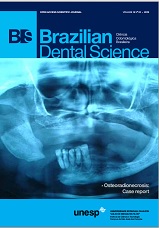Impact of monomer functional groups of resin-based materials on the interaction with water
DOI:
https://doi.org/10.14295/bds.2015.v18i2.1096Resumo
Objective: The objective of this in vitro study was to compare dentin bonding systems and composite resins based on their functional groups in terms of water sorption (WS) and water solubility (WSB). Material and Methods: Three dentin bonding systems (Adper Single Bond 2 – 3M ESPE, Clearfil SE Bond – Kuraray, P90 Adhesive System – 3M ESPE) and three commercial composite resins (Filtek Z350 – 3M ESPE, Filtek Z250 – 3M ESPE, Filtek P90 – 3M ESPE) were tested. Eight specimens of each material were prepared to evaluate the WS and WSA. The discs were individually stored in a desiccator until constant mass was achieved. Specimens were then individually stored in distilled water until the mass was stabilized again. Finally, the specimens were dried again in the desiccator until constant mass was obtained. WS and WSA were calculated from these measurements. Data were analyzed by one-way ANOVA and Tukey post hoc test (p < 0.05). Results: Filtek Silorane-Bond presented the lowest values of WS, and Clearfil SE Bond presented the lowest WSB. Filtek Silorane resin showed the lowest WS and WSA results. Conclusion: Based on the results, it can be concluded that the WS and WSB were influenced by the composition of the materials. The main functional group of the materials determines their susceptibility to water and influences their performance.
Downloads
Downloads
Publicado
Como Citar
Edição
Seção
Licença
TRANSFERÊNCIA DE DIREITOS AUTORAIS E DECLARAÇÃO DE RESPONSABILIDADE
Toda a propriedade de direitos autorais do artigo "____________________________________________________________________" é transferido do autor(es) para a CIÊNCIA ODONTOLÓGICA BRASILEIRA, no caso do trabalho ser publicado. O artigo não foi publicado em outro lugar e não foi submetido simultaneamente para publicação em outra revista.
Vimos por meio deste, atestar que trabalho é original e não apresenta dados manipulados, fraude ou plágio. Fizemos contribuição científica significativa para o estudo e estamos cientes dos dados apresentados e de acordo com a versão final do artigo. Assumimos total responsabilidade pelos aspectos éticos do estudo.
Este texto deve ser impresso e assinado por todos os autores. A versão digitalizada deverá ser apresentada como arquivo suplementar durante o processo de submissão.




























